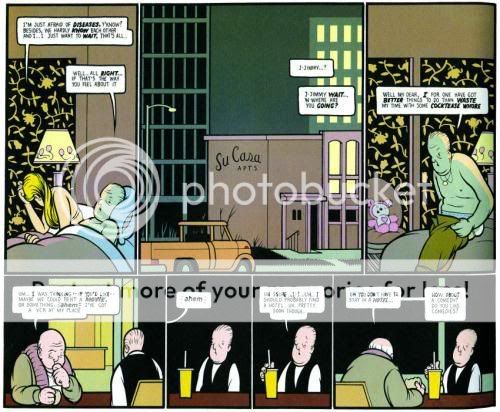I’m batting cleanup. & I think Tom, Miriam, & Noah are perfect just as they are. So no suggestions for what they just have to read (outside every manga column I’ve ever written for TCJ).
Just three bunts, written listening to Animetal Lady:
The Point of Manga Is…
…to cocoon. Not just in shelves & shelves of 40, 50, 100 volume series– in character goods, posters, costumes, movies, soundtracks. Pencil boards, cel phones, cow catchers. You can use the new Kramers Ergot as a pup tent, but all of Dragonball could build the Great Wall.
The rest of it could fill the Great Pacific Garbage Patch.
 On land, people cocooned in manga cafes, even living them. Hikikomori, humorously presaged in Otaku no Video, who fear the sun. It’s all rather urban, where life’s a series of little boxes. Like the model-builder in Otomo’s Domu, the best comic on Brutalist architecture.
On land, people cocooned in manga cafes, even living them. Hikikomori, humorously presaged in Otaku no Video, who fear the sun. It’s all rather urban, where life’s a series of little boxes. Like the model-builder in Otomo’s Domu, the best comic on Brutalist architecture.
 Also like the great wall of Mao’s Little Red Books in La Chinoise. But for fantasists, not ideologues. Otaku don’t conceal & carry.
Also like the great wall of Mao’s Little Red Books in La Chinoise. But for fantasists, not ideologues. Otaku don’t conceal & carry.…to Globalize the Youngsters (aka “The Daihatsu and the Olive Tree”).
If the 21st Century City is Asian, at least 20th Century Pop was American.
Every other country just imitates our pop culture, or at least they did. (I’m sure someone will comment me down. Knock yourself out, but give specific examples of a non-American pop scene that has spread worldwide like syphillis. What’ve you got, Godard? Scandinavian metal? Okay, Brits have a point if the Beatles leapt whole from Chuck Berry’s skull.)
The few robust pop pockets– Bollywood– usually traveled only with the diaspora. Anime & manga, though, had precious few immigrants to spread them. So foreigners stepped up.
They did well: you can find manga-style pop everywhere from Kuala Lumpur to Krakow.
I don’t know what the next non-American All-World pop culture phenom will be. My money’s not on Eurovision. I do know that there will be one. If it’s like manga, following it will take a big commitment– it’s two full-time jobs keeping up with translations and nobody’s hiring. It will have its own language and rules that make it seem exclusive. It will be modern but not Western, just like Japan.
And it will be some kind of sexy.
All of which explain part of Western manga/anime fandom. I always thought the point was to get all the non-prom kids to dress in notional wisps of spandex and pack them in steamy hotels at the height of summer. Good for them!
The only problem is, they’ll teach their kids to like Japan better than the US of A, so when Taro Aso shows up and peels off his skin to reveal the Reaper, we’re doomed. Unless we got a new president yesterday and our foreign policy’s changed.
Finally: the point of manga is best explained by Asian Steve.
He’s subtle Yin to blackasthenight‘s husky Yang. He has a radio show on a college station somewhere in the sticks. He plays K-Pop, though I doubt he’s from Incheon.
I caught it in the car, not long after a stint working on farm in Kurume with a trio of Korean college kids who belted songs at the pears all day. They spoke of Boa, so I called the station.
"This is Asian Steve."
"Hi, Asian Steve. Do you take requests?"
"YES! YES! What do you want to hear?"
"Boa?"
"Which album?"
"I don't know!"
Then Asian Steve and I rocked to Boa as I drove into the sun. You weren’t invited, but we preferred it that way. Soon I arrived at the gent’s club, where I toasted in High Latin as we all tried to forget we’re surrounded by tobacco fields planted with crystal-meth users.
Conclusion: manga breeds Asian Steves. Great explainers, evangelists. But their chief should have the Christian name of Ron. “Manga Ron.” Get it?
???! I’m hilarious.
Anyway, that’s part of the point, right? Finding your own private ecosystem and then explaining the biodiversity within is a joy. Of course, that perspective dates me. Many readers younger than me don’t see the divisions, I think. And a handful of cartoonists, like Hilary Florido and Laura Park, effortlessly mix influences. They both lift from manga stuff that suits them, ditch the rest, and draw with a sense of Western cartoon history in their lines.
Sweet. Global culture, here we come.


